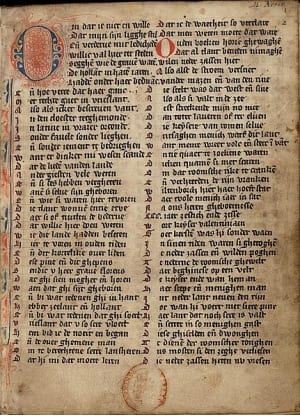
At the Blog we love to hear how scientists are using our DNA to unlock the mysteries of our ancestors. In fact, hardly a week goes by when we don’t report on the latest discovery in the field of genetic ancestry.
Occasionally, however, researchers manage to uncover some mystery of the human past using the DNA of another species. Take the stomach parasite Helicobacter pylori, for example, or the ever-popular louse.
Now an interdisciplinary team of scholars from North Carolina State University, led by assistant professor of English Dr. Timothy Stinson, has developed a means of using cow DNA to determine the origins of medieval manuscripts.
Traditionally, scholars rely on handwriting and subtle differences in dialect to identify the origins of medieval manuscripts, which have often proven unreliable. But there’s another clue: the parchment itself. Parchment, unlike paper, is actually made from animal skins. From the earliest civilizations in Eygpt, Greece, and Rome, scribes often used parchment for their written records. During the Middle Ages, the use of parchment extended to religious texts and other kinds of manuscripts. Sheepskin, calfskin, or goatskin would be stretched thin and dried, cut into appropriate sizes, and bound together in book form.
That’s harsh treatment for a molecule as delicate as DNA. Yet when scribes prepared these strips of parchment, the DNA from the skin of the animal — be it cow, sheep, or goat, was not easily removed. Instead, some parts of the animal’s DNA — specifically, the mitochondrial DNA, remained on the piece of parchment. Using state-of-the-art DNA extraction technology, Stinson and his colleagues have extracted and analyzed the DNA from two 15th-century French manuscripts. Their initial goal was to test whether they could in fact retrieve any DNA at all. If so, they hoped to learn what that DNA might tell them.
Initially, the DNA tests revealed that the pages all seemed to come from the same animal: Bos taurus, otherwise known as the domestic cow. But when the scientists analyzed the DNA more closely, they found that the different pages of the same manuscripts each shared the same mitochondrial DNA. Their conclusion: it’s likely that each manuscript was made of hide from the same animal (or at the very least, very closely related individuals). This means that the pages of parchment might have been prepared around the same time, rather than pieced them together from a variety of different sources.
More than simply identifying the species of animal used in creating these pages of parchment, there are many other benefits that can be gained from DNA analysis of medieval manuscripts. Stinson hopes that genetic testing of these manuscripts can help scholars discover exactly when and where they were produced.
Soon, Stinson hopes that genetic testing of manuscripts “will also allow us to trace trade routes of parchments” throughout medieval Europe. Traditional theories on the origins of individual manuscripts can finally be put to the test using genetic evidence, and medieval scholars would have a new tool to use when tracing the evolution of the medieval book industry.
It is clear that, just as the rise in prominence of human DNA analysis has revolutionized the fields of archaeology and anthropology, so too can the DNA analysis of medieval manuscripts revolutionize the fields of history and literature. Dr. Stinson discusses DNA testing of medieval manuscripts at the Bibliographical Society of America in New York City on January 23.



